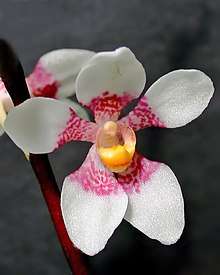Sarcochilus
Sarcochilus, commonly known as butterfly orchids or fairy bells[4]:446–447 is a genus of about twenty species of flowering plants in the orchid family, Orchidaceae. Most species are epiphytes but a few species only grow on rocks or in leaf litter. Orchids in this genus usually have short stems, leaves arranged in two rows and flowers arranged along unbranched flowering stems. Most species are endemic to Australia but some are found in New Guinea and New Caledonia.
| Sarcochilus | |
|---|---|
.jpg) | |
| Illustration of Sarcochilus fitzgeraldii from Fitzgerald's Australian Orchids[1] | |
| Scientific classification | |
| Kingdom: | Plantae |
| Clade: | Tracheophytes |
| Clade: | Angiosperms |
| Clade: | Monocots |
| Order: | Asparagales |
| Family: | Orchidaceae |
| Subfamily: | Epidendroideae |
| Tribe: | Vandeae |
| Subtribe: | Aeridinae |
| Genus: | Sarcochilus R.Br.[2] |
| Type species | |
| Sarcochilus falcatus | |
| Synonyms[2] | |
Description
Orchids in the genus Sarcochilus are epiphytic or lithophytic monopodial herbs with fibrous stems and long, relatively broad leaves folded lengthwise and arranged in two ranks. The flowers are scented, resupinate and arranged on an unbranched flowering stem, each flower on a short thin stalk. The sepals and petals are free from and similar to each other except that the petals are usually smaller than the sepals. The labellum is hinged to the column and has three lobes. The sides lobes are relatively large and upright, sometimes curving inwards. The structure of the middle lobe varies between species.[4][5][6][7]
Taxonomy and naming
The genus Sarcochilus was first formally described in 1810 by Robert Brown and the description was published in Prodromus Florae Novae Hollandiae et Insulae Van Diemen.[3][8] The name Sarcochilus is derived from the Ancient Greek words sarx meaning "flesh"[9]:47 and cheilos meaning "lip",[9]:200 referring to the fleshy labellum of these orchids.[5]
The genus Sarcochilus has been shown to be non-monophyletic.[10]
Species
The following is a list of Sarcochilus species recognised by the World Checklist of Selected Plant Families as at December 2018. The common names in the list below are those used by David Jones.[2][4]:447–452
- Sarcochilus argochilus D.L.Jones & M.A.Clem., 2006 northern lawyer orchid
- Sarcochilus australis (Lindl.) Rchb.f. in Walp., 1863 butterfly orchid, Gunn's tree orchid
- Sarcochilus borealis (Nicholls) D.L.Jones & M.A.Clem., 1989 small lawyer orchid
- Sarcochilus ceciliae F.Muell., 1865 fairy bells
- Sarcochilus chrysanthus Schltr., 1913 (New Guinea)
- Sarcochilus dilatatus F.Muell., 1859 brown butterfly orchid
- Sarcochilus falcatus R.Br., 1810 orange blossom orchid
- Sarcochilus fitzgeraldii F.Muell., 1870 ravine orchid
- Sarcochilus gildasii N.Hallé, 1986 (New Caledonia)
- Sarcochilus hartmannii F.Muell., 1874 large boulder orchid
- Sarcochilus hillii (F.Muell.) F.Muell, 1860 myrtle bells
- Sarcochilus hillii var. hillii.
- Sarcochilus hillii var. thycola N.Hallé, 1986
- Sarcochilus hirticalcar (Dockrill) M.A.Clem. & B.J.Wallace, 1998 harlequin orchid
- Sarcochilus iboensis Schltr., 1913 (New Guinea)
- Sarcochilus koghiensis Schltr., 1911 (New Caledonia)
- Sarcochilus odoratus Schltr., 1913 (New Guinea)
- Sarcochilus parviflorus Lindl., 1838 southern lawyer orchid, green tree orchid
- Sarcochilus rarus Schltr., 1906 (New Caledonia)
- Sarcochilus serrulatus D.L.Jones, 1972 banded butterfly orchid
- Sarcochilus spathulatus R.S.Rogers, 1927 small butterfly orchid
- Sarcochilus tricalliatus (Rupp) Rupp, 1951
- Sarcochilus uniflorus Schltr., 1913 (New Guinea)
- Sarcochilus weinthalii F.M.Bailey, 1903 blotched butterfly orchid
Hybrids
The species S. falcatus, S. fitzgeraldii and S. hartmannii have been hybridized, often with S. australis, producing rounder, cherry-red flowers. A few examples are : S. Fitzhart (hartmannii × fitzgeraldii), S. Heidi (Fitzhart × hartmannii), S. Arcadia (Lois × Fitzhart) and S. George Colthup (Melba × hartmannii).
Intrageneric hybrids include
- × Aeridochilus (Aerides × Sarcochilus)
- × Gastrosarcochilus (Gastrochilus × Sarcochilus)
- × Luichilus (Luisia × Sarcochilus)
- × Malcolmcampbellara (Drymoanthus × Plectorrhiza × Sarcochilus)
- × Parachilus (Parasarcochilus × Sarcochilus)
- × Plectochilus (Plectorrhiza × Sarcochilus)
- × Pomatochilus (Pomatocalpa × Sarcochilus)
- × Porterara (Rhynchostylis × Sarcochilus × Vanda)
- × Rhinochilus (Rhinerrhiza × Sarcochilus)
- × Sarcocentrum (Ascocentrum × Sarcochilus)
- × Sarcomoanthus (Sarcochilus × Drymoanthus)
- × Sarconopsis (Phalaenopsis × Sarcochilus)
- × Sarcorhiza (Rhinerrhiza × Sarcochilus)
- × Sarcothera (Renanthera × Sarcochilus)
- × Sarcovanda (Sarchilus × Vanda)
- × Sartylis (Rhynchostylis × Sarcochilus)
- × Sladeara (Doritis × Phalaenopsis × Sarcochilus)
- × Uptonara (Phalaenopsis × Rhynchostylis × Sarcochilus)
Use in horticulture
The term "sarco" is often used to refer to a number of orchid genera, including Sarcochilus. Most species of Sarcochilus are easily grown but some are very difficult. They need bright light, high humidity and free air movement.[4][11]
References
- Fitzgerald, Robert D. (1882). Australian Orchids. Sydney: Government Printer. Retrieved 3 January 2019.
- "Sarcochilus". World Checklist of Selected Plant Families (WCSP). Royal Botanic Gardens, Kew.
- "Sarcochilus". APNI. Retrieved 3 January 2019.
- Jones, David L. (2006). A complete guide to native orchids of Australia including the island territories. Frenchs Forest, N.S.W.: New Holland. ISBN 1877069124.
- "Sarcochilus". Trin keys. Retrieved 3 January 2019.
- Jeanes, Jeff. "Sarcochilus". Royal Botanic Gardens Victoria. Retrieved 3 January 2019.
- Weston, Peter H. "Sarcochilus". Royal Botanic Garden Sydney. Retrieved 3 January 2019.
- Brown, Robert (1810). Prodromus Florae Novae Hollandiae et Insulae Van Diemen. London. p. 332. Retrieved 3 January 2019.
- Brown, Roland Wilbur (1956). The Composition of Scientific Words. Washington, D.C.: Smithsonian Institution Press.
- Topik Hidayat, Tomohisa Yukawa and Motomi Ito (August 2005). "Molecular phylogenetics of subtribe Aeridinae (Orchidaceae): insights from plastid matK and nuclear ribosomal ITS sequences". Journal of Plant Research. 118 (4): 271–284. doi:10.1007/s10265-005-0217-3. PMID 16025359.
- Roper, Neville. "Sarcochilus". The Orchid Society of New South Wales. Retrieved 3 January 2019.
- Upton, Walter T. (1992). Sarcochilus Orchids of Australia. Double U Orchids, Balmain. pp. 119 p. ISBN 0-646-09734-2.
External links



_-_cropped.jpg)